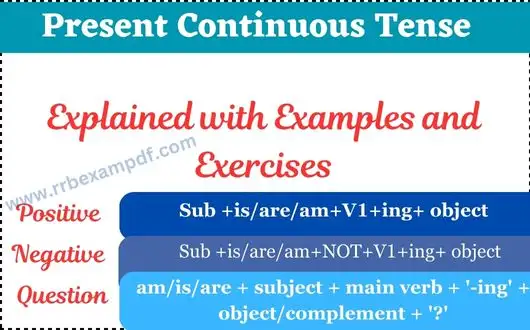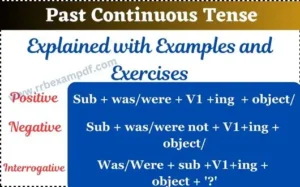Present Continuous Tense with Examples, Exercise: The Present Continuous tense is a fundamental aspect of English grammar, enabling us to describe actions happening at the present moment. Whether you’re a language learner or someone seeking to enhance their writing skills, understanding the different types of sentences and their formulas within the Present Continuous tense is crucial. In this article, we will delve into the various sentence structures, provide formulas for each, and offer practical exercises to solidify your understanding. Let’s embark on this journey to unlock the power of the Present Continuous tense

Types of sentences in Present Continuous Tense
In the Present Continuous Tense the sentences are 3 Types
- Positive/ Affirmative Sentence
- Negative sentences
- Interrogative Sentences
Affirmative Sentences
Affirmative sentences express actions that are happening right now. The formula for constructing affirmative sentences in the Present Continuous tense is as follows:
Subject + auxiliary verb ‘be’ (am/is/are) + main verb + ‘-ing’ + object/complement.
Example:
I am studying for my exam.
She is watching a movie.
Exercise 1:
Construct five affirmative sentences using the Present Continuous tense.
- She is reading a book.
- They are cooking dinner.
- We are studying for the exam.
- I am writing an email.
- He is playing the guitar.
Negative Sentences
Negative sentences are used to express actions that are not happening at the present moment. The formula for constructing negative sentences in the Present Continuous tense is as follows:
Subject + auxiliary verb ‘be’ (am/is/are) + not + main verb + ‘-ing’ + object/complement.
Example:
They are not playing football.
He is not listening to music.
Exercise 2:
Convert the following affirmative sentences into negative sentences using the Present Continuous tense:
a) She is swimming in the pool.
b) We are attending a conference.
Answer:
a) She is not swimming in the pool.
b) We are not attending a conference.
Interrogative Sentences
Interrogative sentences are used to ask questions about ongoing actions. The formula for constructing interrogative sentences in the Present Continuous tense is as follows:
Formula: – Auxiliary verb ‘be’ (am/is/are) + subject + main verb + ‘-ing’ + object/complement + ‘?’
Example:
Are you cooking dinner?
Is she writing a letter?
Exercise 3:
Rewrite the following sentences in the Present Continuous tense as interrogative sentences:
a) They are playing football in the park.
b) He is eating an apple.
Answer:
a) Are they playing football in the park?
b) Is he eating an apple?
Interrogative Negative Sentences
Interrogative negative sentences are used to ask questions about actions that are not happening at the present moment. The formula for constructing interrogative negative sentences in the Present Continuous tense is as follows:
Auxiliary verb ‘be’ (am/is/are) + subject + not + main verb + ‘-ing’ + object/complement + ‘?’
Example:
Aren’t you studying for the test?
Isn’t she watching television?
Exercise 4:
Convert the following affirmative sentences into interrogative negative sentences using the Present Continuous tense:
a) We are having a great time.
b) They are playing chess.
Answer:
a) Aren’t we having a great time?
b) Aren’t they playing chess?
Present Continuous Tense with Examples
You have now grasped the different types of sentences and their formulas in the Present Continuous tense. By practicing these structures and engaging in exercises regularly, you will become proficient in expressing ongoing actions confidently. Remember to incorporate the Present Continuous tense into your speaking and writing, as it adds depth and precision to your language skills. Keep learning and exploring new horizons in English grammar!



